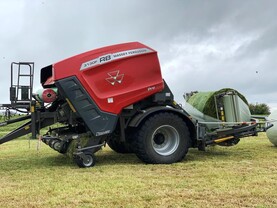After studying agriculture at Greenmount College, Tyrone man Kevin McGrade worked in the construction industry before returning to the family dairy farm in 1998. Since then, Kevin has developed the farm and is now milking 130 cows at Dromore, just outside Omagh.Wet and heavy ground
After studying agriculture at Greenmount College, Tyrone man Kevin McGrade worked in the construction industry before returning to the family dairy farm in 1998. Since then, Kevin has developed the farm and is now milking 130 cows at Dromore, just outside Omagh.
Wet and heavy ground
The McGrades run an autumn-calving herd, producing the majority of their milk during winter months. The farm has very heavy soils and high rainfall.
However, Kevin aims to utilise grazed grass whenever possible and turned the milking cows out to grass 10 days ago.
From 7 February, the herd has been grazing during the day. However, recent heavy rain resulted in the cows returning back inside until ground conditions improve.
Kevin believes in grazing when conditions allow, rather than watching the calendar.
His focus is to develop a strategy that enables him to get the best from his relatively heavy land base.
Grass measurement is a key component of the farm business and last year the farm grew 11.5t DM/ha.
This equates to approximately 1t more than Kevin recorded previously and can largely be attributed to good growing conditions.
The most recent measurement results showed average farm grass cover of 870kg DM/ha on the farm, which supports the rationale for turning cows out.
However, careful management is needed to ensure minimum damage.
The grazing platform is well established on the farm, with good roadways and fencing allowing the herd to utilise grass whenever possible. Kevin maintains that having the flexibility to allow the herd access to paddocks at multiple points and the ability to close paddocks for silage allows him to manage the heavy ground conditions on the farm.
All silage is made in big bales that are labelled with cut date and quality to allow easy and more targeted feeding during winter months. For example, mature grass, which may be a little wet when baled, is labelled low-quality and can be fed to dry cows, whereas young, leafy silage will be labelled high-quality and fed to the milking cows.
The herd
The herd of 130 Holstein Friesian cows has an
autumn-calving profile between August and December. Ten years ago, Kevin was focusing his breeding policy on milk components. More recently, he has decided to target cow fertility when selecting sires.
A 2003 milk solids analysis showed an average herd butterfat and protein of 3.81% and 3.12%, respectively.
However, targeted breeding using EBI-indexed bulls with high milk solids has improved milk solids radically to the current annual herd average of 4.79% butterfat and 3.47% protein.
Average daily milk yield is running at 24 litres/cow/day and all milk is sold to Lakeland Dairies. Meal per cow is averaging 6.8kg and is fed through the parlour on a feed-to-yield basis. Annual production performance is detailed in Table 1.
Farm investment
While grazing infrastructure is well developed, some funds have been earmarked for additional fencing and drainage. The most recent major investment was additional slurry storage and a new 20-point milking parlour in October 2014. Feed space and additional cubicle spaces were also incorporated into the building work. Over a 10-year period, this recent development work will cost the business 3.5ppl at current performance.
However, future expansion of the herd is a long-term objective and will be catered for through homegrown replacements, which will reduce the investment cost to around 3ppl.
The new facilities will allow for the planned expansion in herd size and with spare capacity on the grazing block, Kevin is confident any such expansion will be profitable.
Farm facts
The system
130-cow autumn-calving herd, breeding targets high fertility and milk solids. Milk sold to Lakeland Dairies. Farm growing 11.5t DM/ha grass as of 2014.
Land base
Total area farmed 71ha, with 36ha owned. Land type is heavy clay. Cows can access 56ha on the grazing platform. Replacement heifers reared on-farm.
Work routine
Kevin takes on most of the daily workload and some seasonal work, including slurry spreading and collecting bales, with help from his son Mark when he is not at school. A local contractor is used for baling and wraping.





SHARING OPTIONS: